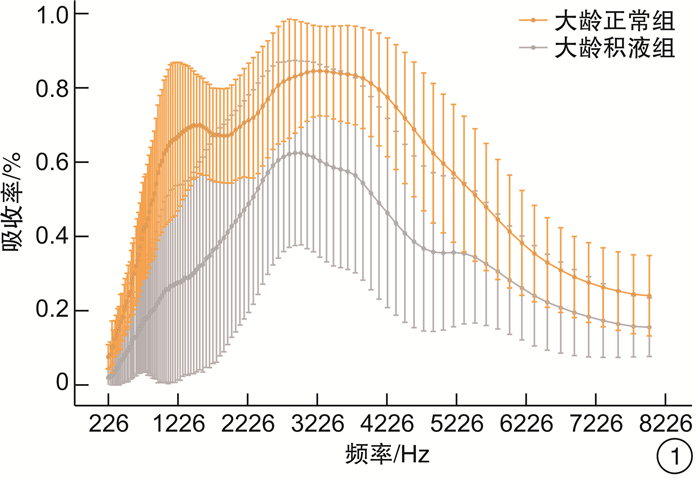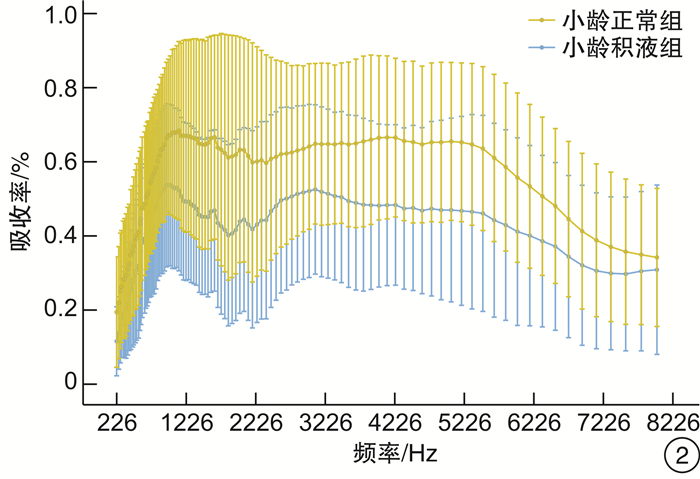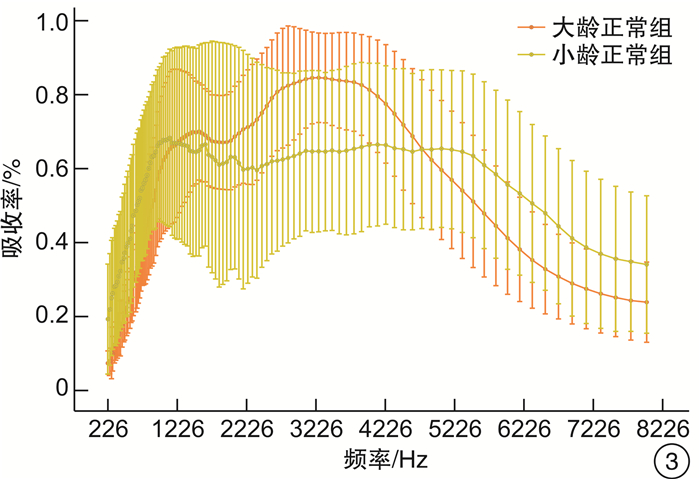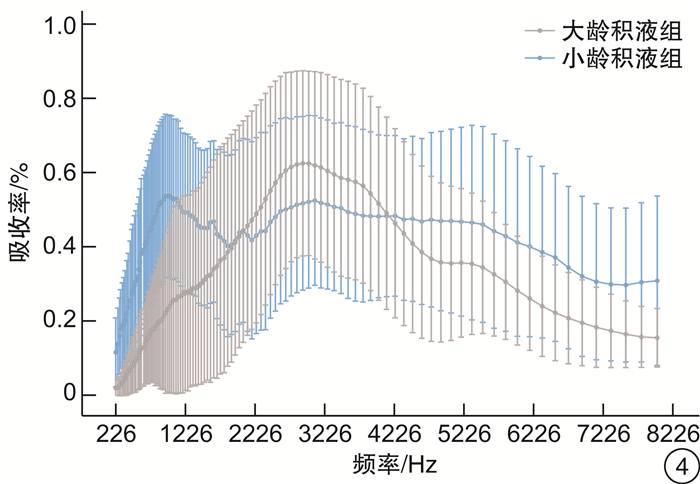Eigenvalue analysis of wideband acoustic immittance in secretory otitis media in children of different ages
-
摘要: 目的 收集不同年龄段儿童在分泌性中耳炎期间的宽频声导抗特征值,比较相同年龄段儿童正常耳和积液耳、不同年龄段儿童正常耳和积液耳的中耳共振频率、声能吸收率的差异。方法 选取82例分泌性中耳炎患儿进行宽频声导抗测试,其中小龄积液组[(3.5±0.7)个月]62例(83耳),大龄积液组[(4.0±0.6)岁]20例(40耳);同时选取82例正常儿童在相同环境下进行宽频声导抗测试,其中小龄正常组62例(124耳),大龄正常组20例(40耳)。将收集到的不同年龄组在宽频峰压下的共振频率、声能吸收率进行比较,并绘制频率-吸收率曲线进行分析。结果 不同年龄段共振频率进行比较,大龄正常组和小龄正常组,大龄积液组和大龄正常组,小龄积液组和小龄正常组,大龄积液组和小龄积液组,其共振频率的差异均有统计学意义(P<0.001)。大龄正常组和小龄正常组在226~1155/4757~8000 Hz声能吸收率差异有统计学意义(P<0.001);大龄积液组和大龄正常组全频率声能吸收率差异有统计学意义(P<0.001),其中866~1542/2520~4362 Hz吸收率差值最大;小龄积液组和小龄正常组全频率声能吸收率差异有统计学意义(P<0.001),其中1091~2245/3776~5494 Hz吸收率差值最大。结论 不同年龄段儿童的中耳积液在宽频声导抗峰压下表现不同,都有各自的特征声能吸收率频段。此项研究为今后儿童在患分泌性中耳炎期间的中耳传声的特征分析提供了一定的参考依据。Abstract: Objective The characteristic values of broadband acoustic immittance of children of different ages during secretory otitis media were collected resonance frequency and absorption rate of middle ear in children of different ages were compared.Methods Eighty-two children with secretory otitis media were selected for the broadband acoustic immittance test, including 62 cases (83 ears) in the young effusion group([3.5±0.7]months), and 20 cases (40 ears) in the older effusion group([4.0±0.6]years old). 82 normal children were selected for broadband acoustic immittance test in the same environment, including 62 cases (124 ears) in the younger normal group and 20 cases (40 ears) in the older normal group. The resonance frequency and absorptivity of different age groups under broadband peak pressure were compared, and the frequency absorptivity curve was drawn for analysis.Results The resonance frequencies of older normal group and younger normal group, older effusion group and older normal group, younger effusion group and younger normal group, older effusion group and younger effusion group were statistically significant(P < 0.001). Analysis of sound energy absorption rate at different ages. There was significant difference in sound energy absorption rate between older normal group and younger normal group at 226-1155/4757-8000 Hz(P < 0.001). The difference of full frequency sound energy absorption rate between the older effusion group and the older normal group was statistically significant(P < 0.001), among which the difference of 866-1542/2520-4362 Hz absorption rate was the largest. The difference of full frequency sound energy absorption rate between young effusion group and young normal group was statistically significant(P < 0.001), and the difference of 1091-2245 / 3776-5494 Hz absorption rate was the largest.Conclusion Middle ear effusion in children of different ages has different performance under broadband acoustic immittance peak pressure, and has its own characteristic acoustic energy absorption frequency band. This study provides a reference basis for the analysis of the characteristics of middle ear sound transmission in children with secretory otitis media in the future.
-
Key words:
- secretory otitis media /
- child /
- wideband acoustic immittance /
- resonance frequency /
- energy absorbance
-

-
[1] Holte L, Margolis RH, Cavanaugh RM Jr. Developmental changes in multifrequency tympanograms[J]. Audiology, 1991, 30(1): 1-24. doi: 10.3109/00206099109072866
[2] 亓贝尔, 刘佳星, 文铖, 等. 听力正常新生儿宽频声导抗特征值初探[J]. 临床耳鼻咽喉头颈外科杂志, 2018, 32(4): 244-249. https://www.cnki.com.cn/Article/CJFDTOTAL-LCEH201804002.htm
[3] Voss SE, Horton NJ, Woodbury RR, et al. Sources of variability in reflectance measurements on normal cadaver ears[J]. Ear Hear, 2008, 29(4): 651-665. doi: 10.1097/AUD.0b013e318174f07c
[4] Cinamon U. The growth rate and size of the mastoid air cell system and mastoid bone: a review and reference[J]. Eur Arch Otorhinolaryngol, 2009, 266(6): 781-786. doi: 10.1007/s00405-009-0941-8
[5] Liu YW, Sanford CA, Ellison JC, et al. Wideband absorbance tympanometry using pressure sweeps: system development and results on adults with normal hearing[J]. J Acoust Soc Am, 2008, 124(6): 3708-3719. doi: 10.1121/1.3001712
[6] 熊琪, 王小亚, 彭峤琛, 等. 172名1-36月婴幼儿的声能吸收率测试分析[J]. 中华耳科学杂志, 2015, 13(3): 422-427. doi: 10.3969/j.issn.1672-2922.2015.03.009
[7] Hunter LL, Keefe DH, Feeney MP, et al. Longitudinal development of wideband reflectance tympanometry in normal and at-risk infants[J]. Hear Res, 2016, 340: 3-14. doi: 10.1016/j.heares.2015.12.014
[8] 郭亿莲, 孙一帆, 张丽娟, 等. 中耳共振频率测试在儿童分泌性中耳炎诊断中的意义[J]. 广东医学, 2012, 33(16): 2452-2454. doi: 10.3969/j.issn.1001-9448.2012.16.035
[9] Kim SY, Han JJ, Oh SH, et al. Differentiating among conductive hearing loss conditions with wideband tympanometry[J]. Auris Nasus Larynx, 2019, 46(1): 43-49. doi: 10.1016/j.anl.2018.05.013
[10] Voss SE, Horton NJ, Woodbury RR, et al. Sources of variability in reflectance measurements on normal cadaver ears[J]. Ear Hear, 2008, 29(4): 651-665. doi: 10.1097/AUD.0b013e318174f07c
[11] Merchant GR, Al-Salim S, Tempero RM, et al. Improving the Differential Diagnosis of Otitis Media With Effusion Using Wideband Acoustic Immittance[J]. Ear Hear, 2021, 42(5): 1183-1194.
[12] Feeney MP, Grant IL, Marryott LP. Wideband energy reflectance measurements in adults with middle-ear disorders[J]. J Speech Lang Hear Res, 2003, 46(4): 901-911. doi: 10.1044/1092-4388(2003/070)
[13] 盛海斌, 周嵌, 李海峰, 等. 低龄儿童分泌性中耳炎宽频声导抗特点及临床意义[J]. 中华耳鼻咽喉头颈外科杂志, 2021, 56(6): 579-585.
-





 下载:
下载:


